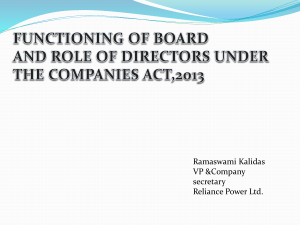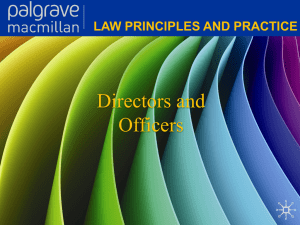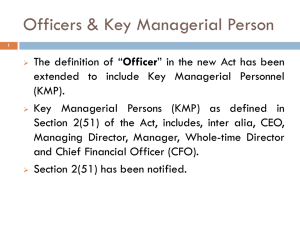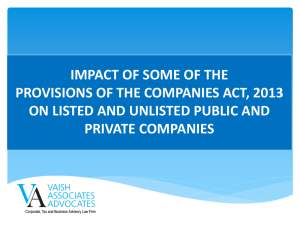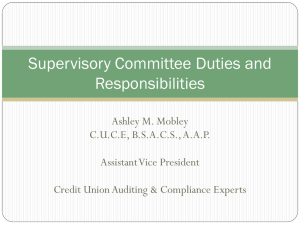Mgmt-Admn-and-Directors-w-out
advertisement
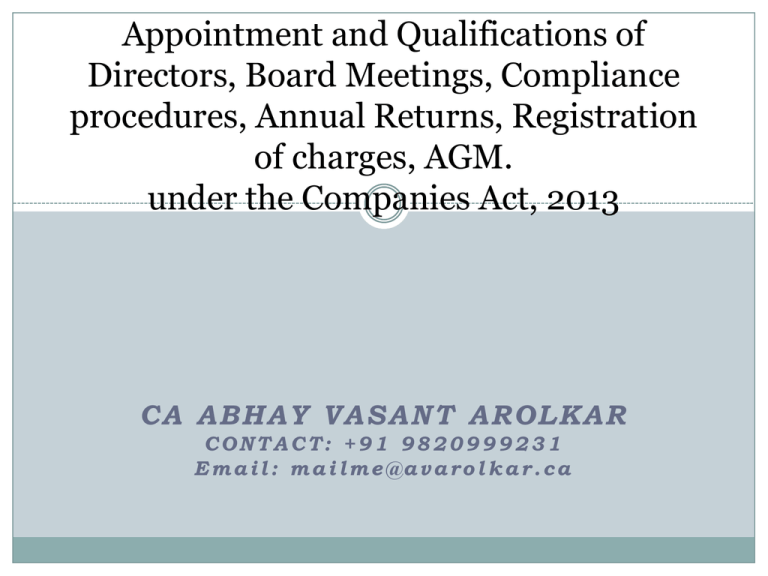
Appointment and Qualifications of Directors, Board Meetings, Compliance procedures, Annual Returns, Registration of charges, AGM. under the Companies Act, 2013 CA ABHAY VASANT AROLKAR CONTACT: +91 9820999231 Email: mailme@avarolkar.ca Definitions Composition of the Legislation Definitions Associate Company [Section 2(6)] 2(6) defines “Associate company”, in relation to another company, means a company in which that other company has a significant influence, but which is not a subsidiary company of the company having such influence and includes a joint venture company. Explanation.—For the purposes of this clause, “significant influence” means control of at least twenty per cent. of total share capital, or of business decisions under an agreement; Definitions (Contd.) Chief Executive Officer [Section 2(18)] 2(18) “Chief Executive Officer” means an officer of a company, who has been designated as such by it; Chief Financial Officer [Section 2(19)] 2(19) “Chief Financial Officer” means a person appointed as the Chief Financial Officer of a company; Control [Section 2(27)] 2(27) defines “control” shall include the right to appoint majority of the directors or to control the management or policy decisions exercisable by a person or persons acting individually or in concert, directly or indirectly, including by virtue of their shareholding or management rights or shareholders agreements or voting agreements or in any other manner; Definitions (Contd.) Key Management Personnel [Section 2(51)] defines “key managerial personnel”, in relation to a company, means— (i) the Chief Executive Officer or the managing director or the manager; (ii) the company secretary; (iii) the whole-time director; (iv) the Chief Financial Officer; and (v) such other officer as may be prescribed; Definitions (Contd.) Promoter [Section 2(69) “promoter” means a person— (a) who has been named as such in a prospectus or is identified by the company in the annual return referred to in section 92; or (b) who has control over the affairs of the company, directly or indirectly whether as a shareholder, director or otherwise; or (c) in accordance with whose advice, directions or instructions the Board of Directors of the company is accustomed to act: Provided that nothing in sub-clause (c) shall apply to a person who is acting merely in a professional capacity; Definitions (Contd.) Related Party [Section 2(76)] “related party”, with reference to a company, means— (i) a director or his relative; (ii) a key managerial personnel or his relative; (iii) a firm, in which a director, manager or his relative is a partner; (iv) a private company in which a director or manager is a member or director; (v) a public company in which a director or manager is a director or holds along with his relatives, more than two per cent. of its paid-up share capital; (vi) any body corporate whose Board of Directors, managing director or manager is accustomed to act in accordance with the advice, directions or instructions of a director or manager; (vii) any person on whose advice, directions or instructions a director or manager is accustomed to act: (professionals excluded) (viii) any company which is— (A) a holding, subsidiary or an associate company of such company; or (B) a subsidiary of a holding company to which it is also a subsidiary; (ix) such other person as may be prescribed Definitions (Contd.) Relative [Section 2(77)] ‘‘relative’’, with reference to any person, means any one who is related to another, if— (i) they are members of a Hindu Undivided Family; (ii) they are husband and wife; or (iii) one person is related to the other in such manner as may be prescribed; Under the Rules, a person is related to the other if he or she is related to another in the following manner: Father (including Step-father) ; Mother (including step-mother) Son (including Step-son); Son’s wife Daughter; Daughter’s husband Brother (including step-brother) Sister (including step-sister) Definitions (Contd.) Small Company [Section 2(85)] ‘‘small company’’ means a company, other than a public company,— (i) paid-up share capital of which does not exceed fifty lakh rupees or such higher amount as may be prescribed which shall not be more than five crore rupees; or (ii) turnover of which as per its last profit and loss account does not exceed two crore rupees or such higher amount as may be prescribed which shall not be more than twenty crore rupees: Provided that nothing in this clause shall apply to— (A) a holding company or a subsidiary company; (B) a company registered under section 8; or (C) a company or body corporate governed by any special Act; Definitions (Contd.) Subsidiary company [Section 2(87)] “subsidiary company” or “subsidiary”, in relation to any other company (that is to say the holding company), means a company in which the holding company— (i) controls the composition of the Board of Directors; or (ii) exercises or controls more than one-half of the total share capital either at its own or together with one or more of its subsidiary companies: Provided that such class or classes of holding companies as may be prescribed shall not have layers of subsidiaries beyond such numbers as may be prescribed. Explanation.—For the purposes of this clause,— (a) a company shall be deemed to be a subsidiary company of the holding company even if the control referred to in sub-clause (i) or sub-clause (ii) is of another subsidiary company of the holding company; (b) the composition of a company’s Board of Directors shall be deemed to be controlled by another company if that other company by exercise of some power exercisable by it at its discretion can appoint or remove all or a majority of the directors; (c) the expression “company” includes any body corporate; (d) “layer” in relation to a holding company means its subsidiary or subsidiaries; Management & Administration Register of Members – [Form No. MGT-1] To be compiled within six months from the date of commencement of Rules i.e. April 1, 2014 Seven days’ notice for closure of register Foreign Register – Notice of situation [Form No. MGT-3] Declaration to be filed with the company by the registered owner who does not hold beneficial interest – [Form No. MGT-4] Declaration to be filed with the company by the beneficial owner who is not the registered owner – [Form No. MGT-5] Return of beneficial interest to be filed by the company with the ROC – [Form No. MGT-6] within thirty days of the receipt of such declaration. Management & Administration Annual Return Detailed Annual return to be filed – [Form No. MGT-7] Certification required by practising Company Secretary [Form No. MGT-8] applicable only in case of in case of companies Having paid up capital of Rs. 10 crores or more; or Having turnover of Rs. 50 crores or more. Extract of Annual Return to be attached to Board’s Report – [Form MGT-9] Return of changes in promoters/top ten shareholders – Form No. MGT-10 Change means increase or decrease by two per cent or more in the shareholding Management & Administration Annual Return Time limit – within 60 days of the AGM held or ought to have been held. Additional period of 270 days allowed with additional fees. Consequences of not filing: Company as well as the officer responsible for the default will be fined Rs. 50,000 which may extend upto Rs. 500,000. Inspection of Registers etc., at the Registered Office Open during business hours at such reasonable time on a working day for a fee Extract to be provided for a fee, not exceeding Rs. 10 per page within seven days of the deposit of such fee. Management & Administration Preservation of records – Register of members with index : Permanently Register of debentureholders or any other security : eight years from the date of redemption Copies of Annual Return : eight years from the date of filing Foreign register : permanently Management & Administration General Body Meetings Annual General Meetings (AGM) Not applicable to OPC Gap of not more than 15 months between two AGMs First AGM within 9 months of the first financial year. Exempt from holding AGM in the year of incorporation To be called during business hours and not on National holidays. Attendance of auditor is mandatory Exemption may be granted on such conditions as it may deem fit by the Central Government Adjourned Meeting Management & Administration General Body Meetings (Contd.) Power of Tribunal to call AGM Default will attract penalty – Fine upto Rs. 1 lakh In case of continuing default – Rs. 5,000 per day during which such default continues Extra-ordinary General Meeting (EGM) Can be requistioned by member holding not less than 1/10th of the share capital or voting power, as the case may be. To be called within 45 days of the date of receipt of requisition, failing which, the requisionists can hold within three months from the date of requisition. Cost to be re-imbursed by the company and recovered from the remuneration payable to defaulting directors Management & Administration Notice of General Meetings Not less than clear twenty one days’ notice in writing or in electronic mode. Shorter notice permitted, in case agreed to by 95% of the members entitled to vote at such meeting. Annexure to Notice in case of Special Business (Section 102) Penalty – upto Rs. 50,000 or five times the amount of benefit accruing to the director/promoter etc., whichever is more. Management & Administration Notice of General Meetings (contd.) Ordinary Business at an AGM means : Consideration of financial statements, Directors’ Report and Auditor’s Report Declaration of dividend Appointment of director in place of those retiring Appointment of auditor and fixing their remuneration All other business at the AGM and all businesses at EGM shall be Special Business Report on Annual General Meeting By Listed Companies only Form No. MGT-15 Quorum Public Companies – the quorum for a general meeting shall be: Where No. of members not more than 1,000 :- 5 members* Where No. of members >1,000 <= 5,000 : - 15 members* Where No. of members >5,000 :- 30 members* Private Companies – the quorum for a general meeting shall be 2 members* * personally present Where the quorum is not present, the meeting shall stand adjourned to the next week at the same time and place on the same day or at such other time as the Board may determine for which at least three days’ notice shall be given. However in case of a requisitioned meeting, the same shall stand cancelled. Management & Administration Proxy To attend and vote on a poll Proxy not to represent more than 50 members and not holding more than 10% of the total share capital carrying voting rights. To be submitted 48 hours before the meeting Proxy in Form No. MGT.11 Right to inspect proxies subject to conditions Resolutions Ordinary – where votes cast in favour are more than the votes cast against. Special - Where the votes cast in favour are at least three times the votes cast against. File Special Resolution with ROC in Form No. MGT.14 Management & Administration Poll Either by the Chairman on his motion or if demanded by members holding more than 1/10th of the voting power or holding shares of not less than Rs. 5 lakhs. Voting through electronic means Every listed company having 1,000 or more members shall provide this facility. Detailed procedure laid down for companies which opt for providing this facility Ballot paper – Form No. MGT-12 Report of the Scrutinizer(s) – Form No. MGT-13 Management & Administration Minutes of the Meeting To be prepared within 30 days of the meeting Distinct minute book for each type of meeting Brief note on postal ballot, if any. Each page to be initialled and signed on the last page of the record of the proceedings of each meeting Maintained at the registered office Preserved permanently Inspection of minute book of general meeting or providing copy thereof. Penalty for non-compliance : Rs. 5,000 for the company and every officer responsible. In case of continuing default, Rs. 500 per day. Management & Administration Maintenance and Inspection of documents in electronic form: Formats as per the Act and Rules made thereunder. Capable of being dated and signed digitally Future reference possible – records should be readable, retrievable and reproducible in printed form Edition or alteration should not be permissible Capable of being updated Adequate security Inspection Board of Directors Appointment of Directors Maximum Number of directors Resident Director Independent Directors Woman Director Alternate Director Whole-time Director Remuneration of managerial personnel Deposit for persons contesting directorship Resignation of Directors Duties of Directors Vacation of Office Board of Directors Resolution by circulation Resolution to be circulated together with necessary papers Circulated to all directors/committee members either by hand delivery, post, courier or through electronic means Where not less than one third of the total number of directors require any such resolution to be considered at a Board Meeting, the chairperson shall put the resolution to be decided at a meeting of the Board Such resolution by circulation to be noted at the subsequent meeting of the Board/Committee and made part of such meeting. Board of Directors Appointment of Directors [Section 149] Minimum No. of Directors : Private Co. – Two Public Co. – Three Maximum Number of directors : Fifteen Resident Director : Every company shall have at least one director who has stayed in India for a total period of not less than one hundred and eighty-two days in the previous calendar year. Woman Director Such class or classes of companies as may be prescribed, shall have at least one woman director. Board of Directors Independent Directors are A person of integrity and possesses relevant expertise and experience Is not a promoter or related to promoter/directors* No pecuniary relationship* Whose relatives do not have pecuniary interest or transaction* of more than 2% of its gross turnover/total income or rupees fifty lakh, whichever is lower during the last two financial years or the current financial year Holds, together with the relatives more than 2% of the total voting power of the company. Is not a key managerial personnel or an employee/past employee* or an employee /past employee Is a CEO /Director of a NGO that receives 25% or more of its receipts * of the company, its holding, subsidiary or associate company or their promoters/directors. Board of Directors Independent Directors Listed Companies – One-third of the total number of directors Class of Public companies – as may be prescribed by Central Govt., Code for Independent Directors [Schedule IV] Data Bank of Independent Directors Board of Directors Additional Director Alternate Director Whole-time Director Remuneration of managerial personnel Nominee Director Director elected by small shareholders Board of Directors Director Identification No.: [Section 153 – 159] Forfeiture of Deposit of persons contesting directorship, if he/she fails to more than 25% of total valid votes cast Resignation of Directors Company as well as director to notify ROC with detailed reasons Effective from the date of resignation specified or receipt of the resignation, whichever is later Board of Directors Disqualifications for appointment of a Director Is of unsound mind Undischarged insolvent Convicted of an offence involving imprisonment of not less than 6 months and not less than 5 years have elapsed since the expiry of the sentence. Disqualified by an order of the Tribunal/Court, which is in force. Not paid calls and six months have elapsed since the last day fixed for the payment of the call Convicted of an offence u/s 188 of the Actdealing with related party transactions at any time during last 5 years Does not possess a DIN Board of Directors Disqualification for re-appointment If he is director of a company which Has not filed financial statements/annual return for 3 financial years Defaulted in payment of interest on deposits/dividend or repayment of deposits or redemption of debentures. Disqualification for 5 years from the date of default Duties of Directors Shall act in good faith, promote the objects of the company, act in the best interests of the stakeholders, exercise due and reasonable care skill and diligence and independent judgement, avoid conflict of interest, not achieve or attempt to achieve any undue gain, and shall not assign his office. Vacation of Office If he is disqualified Absents himself from all meetings held during the twelve months, with/without seeking leave of absence. Acts in contravention or Contravenes the provisions of Section 184 (Disclosure of interest) Disqualified by an order of Tribunal/Court Convicted of an office involving imprisonment of not less than 6 months, irrespective whether the director has appealed against the sentence or not. Removed under the provisions of Act. He, having been appointed by virtue of his holding any office or employment in the holding/subsidiary or associate company and he ceases to hold such office or employment Board of Directors Board Meetings No. of Board Meetings Video-conferencing etc., Notice Withdrawal of resolution Committees Nomination and Remuneration Committee Stakeholders’ Relationship Committee Corporate Social Responsibility Committee Audit Committee Corporate Social Responsibility Directors’ Report Code for Independent Directors Board of Directors Loan to Directors Related party transactions Prohibition of insider dealings and forward dealings Vigil Mechanism [Whistleblower] Board of Directors Board Meetings No. of Board Meetings : four Video-conferencing etc., Notice : seven days’ notice in writing Withdrawal of resolution Committees Nomination and Remuneration Committee Stakeholders’ Relationship Committee Corporate Social Responsibility Committee Audit Committee Defects in appointment of Directors not to invalidate actions taken Board of Directors Quorum One third of its total strength or two directors whichever is higher. Any fraction of a number to be rounded off as one In case of absence of independent directors, decisions taken at such meetings to be circulated to all directors and shall be final only on ratification by at least one independent director Voting by non-interested directors only. Where the number of interested directors exceeds two thirds of the total strength, such number of directors who are non-interested and not being less than two shall form the quorum Board of Directors Quorum If at a Board Meeting, quorum is not present, the meeting shall stand adjourned to the same day at the same time and place in the next week. If the same is a national holiday, then on the next succeeding day which is not a national holiday. If the total strength falls below the number required for quorum, the continuing directors may act to either increase the number of members to the minimum required by the Act or summoning the general body meeting and for no other purpose. Every director to attend at least one meeting in person, where meetings are held through video conferencing or Other Audio Visual means Board of Directors Resolution by circulation Resolution to be circulated together with necessary papers Circulated to all directors/committee members either by hand delivery, post, courier or through electronic means Where not less than one third of the total number of directors require any such resolution to be considered at a Board Meeting, the chairperson shall put the resolution to be decided at a meeting of the Board Such resolution by circulation to be noted at the subsequent meeting of the Board/Committee and made part of such meeting. Nomination and Remuneration Committee Applicable to listed company and other prescribed class of companies Constitution : Minimum 3 non-executive directors, majority of whom shall be independent directors. Chairperson of the company can be a member but not the chairperson of the committee. Functions include: Identification of qualified Directors and Senior Management Personnel Relationship of remuneration to performance is clear meets the benchmark Recommend policy for remuneration Remuneration policy to be disclosed in the Directors’ Report Stakeholders Relationship Committee Applicable to a company having more than one thousand shareholders, debenture-holders and any other security holders Constitution : to be decided by the Board of Directors. Chairperson shall be a Non-executive director Functions include considering and resolving the grievances of security holders Audit Commitee Applicable to listed company and other prescribed class of companies Constitution : Minimum 3 directors, majority of whom shall be independent directors Majority of the members shall have ability to read and understand financial statements Functions include Recommend appointment and terms of appointment of auditors appraisal of effectiveness of audit process, review auditor’s independence and performance Examination of financial statements and auditor’s report thereon. Approval / subsequent modification of related party transactions scrutiny of inter-corporate loans and investments, evaluation of internal financial controls and risk management systems. Vigil mechanism in place Corporate Social Responsibility Corporate Social Responsibility Applicable to every company having net worth of rupees five hundred crore or more; or turnover of rupees one thousand crore or more; or a net profit of rupees five crore or more during any financial year. Shall constitute a Corporate Social Responsibility Committee of the Board consisting of three or more directors, out of which at least one director shall be an independent director. Board of Directors Loan to Directors Save as otherwise provided in this Act, no company shall, directly or indirectly, advance any loan, including any loan represented by a book debt, to any of its directors or to any other person in whom the director is interested or give any guarantee or provide any security in connection with any loan taken by him or such other person: Vigil Mechanism [Whistleblower][Section 177(10) The vigil mechanism under sub-section (9) shall provide for adequate safeguards against victimisation of persons who use such mechanism and make provision for direct access to the chairperson of the Audit Committee in appropriate or exceptional cases: Provided that the details of establishment of such mechanism shall be disclosed by the company on its website, if any, and in the Board’s report. Related Party Transactions etc., Prohibition of insider dealings and forward dealings Related party transactions No specified related party transactions except with the consent of the Board Shall not exceed the prescribed limits, except with prior approval by special resolution. No member shall vote on such on such resolution, if he is a related party. Ratification permitted within 3 months. Not applicable in case of transactions in the ordinary course of business at arm’s length price. Disclosure in Directors’ Report with justification. Directors shall make good the loss if any from contracts or arrangements without the necessary approval Registration of Charges Chapter VI [Sections 77 to 87] Duty to register charges etc.: A company creating a charge, shall, register the particulars of the said charge with the ROC within 30 days of its creation. [Form No. CHG 1 for other than Debentures and Form No. CHG 9 for Debentures] This charge could be: • on its property or assets or any of its undertakings whether tangible or otherwise Situated in or outside India Signed by both the Company and the charge-holder together with the instruments creating the charge. Registration of Charges Rule 3 (4)(a) where the instrument or deed relates solely to the property situate outside India, the copy (instrument evidencing the creation/modification) shall be verified by: a certificate issued either under the seal of the company or under the hand of any director or company secretary of the company; or an authorised officer of the charge holder or under the hand of some person other than the company who is interested in the mortgage or charge, stating that it is a true copy; Rule 3 (4)(b) where the instrument or deed relates, whether wholly or partly, to the property situate in India, the copy shall be verified by: a certificate issued under the hand of any director; or company secretary of the company; or an authorised officer of the charge holder stating that it is a true copy. Registration of Charges Charges requiring registration a charge created for the purpose of securing any issue of debentures or deposits; a charge on uncalled share capital of the company; a charge on any immovable property, wherever situate, or any interest therein; a charge on any book debt of the company; a charge, not being a pledge, on any movable property of the company; Charges requiring registration a floating charge on the undertaking or any property of the company including stock-in-trade; a charge on calls made but not paid; a charge on a ship or any share in a ship; a charge on intangible assets, including goodwill, patent, a licence under a patent, trade mark, copyright or a licence under a copyright. Registration of Charges • Application for Registration of charge in Form No. • • • • CHG 1. In case the company fails to get the charge registered, then the charge-holder may apply to ROC for the registration of the same On receiving such application, the ROC shall send notice to company And within 14 days, unless the company doesn’t show sufficient cause as to why the said charge should not be registered, shall register the charge without signature of company The said charge-holder shall be entitled to recovery of fees and additional fees paid to ROC from the company ROC shall issue a certificate of registration of such charge in Form No. CHG 2 ROC shall issue a certificate of modification of charge in Form No. CHG 3 The certificate issued by the ROC shall be conclusive evidence that the requirements of Chapter VI of the Act and the rules have been complied with. The liquidator or any other creditor shall not take into account any charge created unless registered with the Registrar. Registration of Charges Intimation of satisfaction of charge to be given to the ROC in Form No. CHG 4 within a period of 30 days from the date of such satisfaction ROC to issue memorandum of satisfaction in Form No. CHG 5. If a form is filed without the signature of charge-holder, ROC shall send notice to the charge-holder calling upon him to show cause within such time not exceeding 14 days, as to why the satisfaction should not be recorded. If no cause shown, ROC will register. Where the company fails to send intimation of satisfaction of charge to the ROC, who receives evidence of the satisfaction of charge from any other person, such as charge–holder, shareholder, or purchaser. However, the power is subject to evidences being produced to his satisfaction. ROC shall issue a certificate of registration of satisfaction of charge in Form No. CHG 5. Intimation [in Form No. CHG 6] within 30 days to the ROC of the appointment/cessation thereof, as Receiver or Manager of the property so charged [Section 84] Where any person obtains an order for the appointment of a receiver; or of a person to manage the property, which is already subject to a charge of a company; Where any person appoints such receiver/ manager under any power contained in any instrument Registration of Charges The provisions of registration of charges shall equally apply to: a company acquiring any property subject to a charge; or any modification in the terms or conditions or the extent or operation of any registered charge Where any person acquires a property, asset or undertaking in respect of which a charge has already been registered, it would be deemed that he has complete knowledge of that charge from the date the said charge was registered with the ROC Registration of Charges • ROC may on application by the company, allow this registration within 300 days (30+270), on payment of additional fees • This application shall be supported by a declaration from the company by its secretary or director that such belated delay shall not adversely affect rights of any other creditors of the company • If not within 300 days, company to seek extension of time from the CG; - Form No. CHG 8 • ROC shall not register the charge unless the delay is condoned by the Central Government Register of Charges [Section 85] Every company shall keep at its registered office a register of charges which shall include therein all charges and floating charges affecting any property or assets of the company or any of its undertakings. The instrument creating the charge shall also have to be kept along with the register. The register of charges shall be in Form No. CHG 7 and enter therein particulars of all the charges registered with the Registrar as well as particulars of any modification of charge and that of satisfaction of charge The entries in the said register shall be made forthwith after the creation, modification satisfaction of charge, as the case may be. or Entries in the register shall be authenticated by the secretary of the company or any other person authorised by the Board for the purpose. The register shall be preserved permanently and the instrument creating a charge shall be preserved for a period of 8 years from the date of satisfaction of charge by the company. Inspection of Register Register of charges and the instrument of charges, shall be open for inspection during business hours: by any member or creditor without any payment of fees; or by any other person on payment of such fees as prescribed in Annexure B and subject to such reasonable restrictions as the company may, by its articles, impose. Rectification CG in the register of charges CG on being satisfied that an omission that has occurred: was accidental; or due to inadvertence; or for some other sufficient cause or It is not of a nature to prejudice the position of creditors or shareholders of the company or on any other grounds, it is just and equitable to grant relief Compliances that require your attention Board Report disclosure Annual Return Financial statements Resident Director Change in the constitution of Board of Directors Disqualifications No. of directorships Change in particulars of directors Disclosure of interest Related Party transactions No voting rights to interested directors Board meetings’ notice in writing Minutes of Board Meeting Vacation of office Loans to Directors Loans from Directors Vigil Mechanism Corporate Social Responsibility Compliances Penalties Director’s liability under the new Act. Entrenchment Disgorgement Overview of Companies Act, 2013 By CA Abhay Vasant Arolkar BCom (Hons.), LLB, ACS, FCA M/s. A.V.Arolkar & Co., Chartered Accountants, Mobile – 98209 99231 email – mailme@avarolkar.ca

